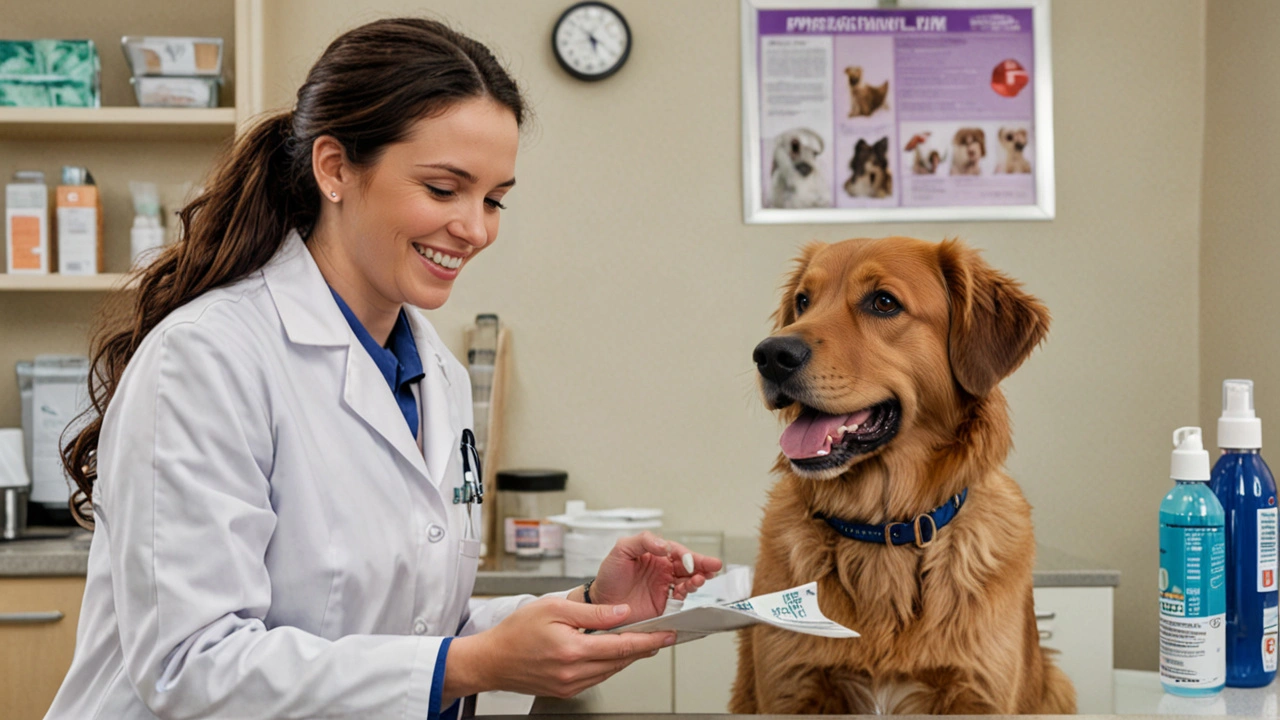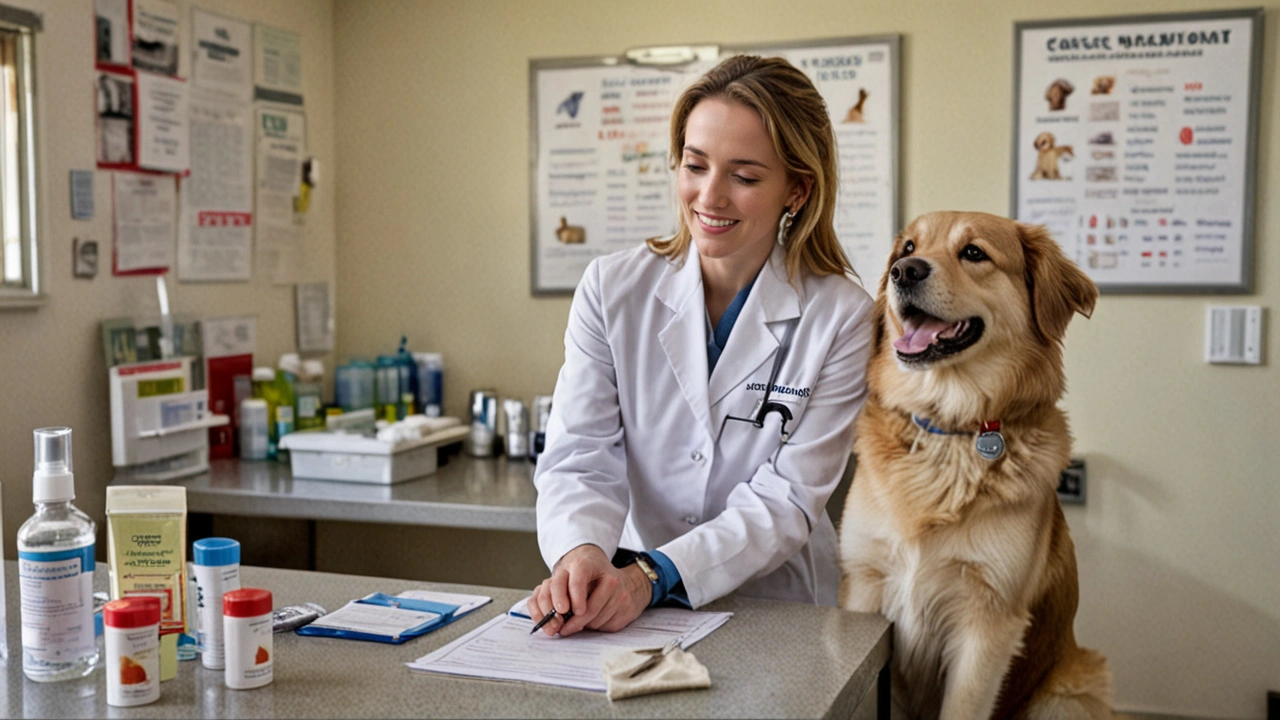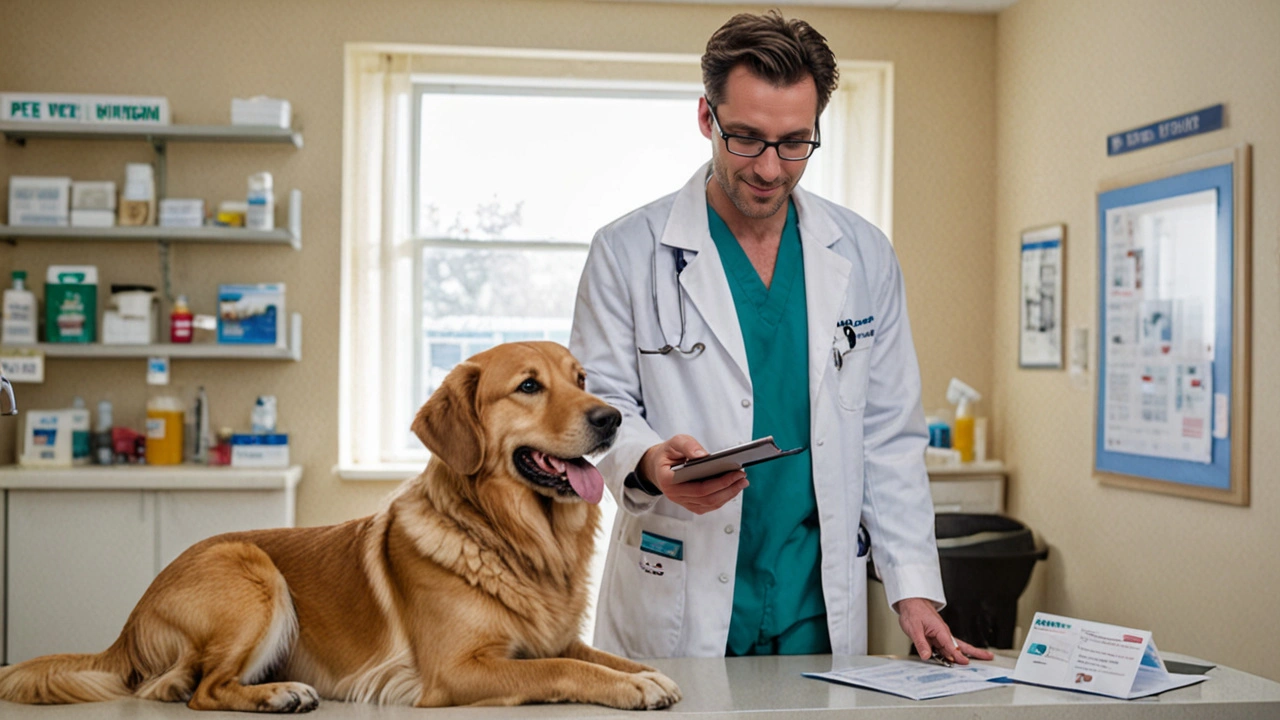If your pet is struggling with allergies, it's essential to provide them with the right care and medication. One commonly prescribed remedy is Cyproheptadine, an antihistamine known for its effectiveness in reducing allergic reactions. But, just like with any medication, using it correctly ensures your pet's safety and well-being.
In this article, we'll walk you through everything you need to know about Cyproheptadine—from what it is and how it works to dosage guidelines and potential side effects. We will also share some practical tips to help you administer this medication with confidence. Let’s explore how you can help your pet breathe easier and live more comfortably.
- Introduction to Cyproheptadine
- Dosage Guidelines
- Potential Side Effects
- Additional Tips and Precautions
Introduction to Cyproheptadine
Cyproheptadine is an antihistamine primarily used to treat allergic reactions in pets, including cats and dogs. Originally developed for humans, it has found its way into veterinary medicine due to its effectiveness in blocking histamines, which are chemicals in the body that cause allergy symptoms. If you've ever wondered how this medication helps or why it's prescribed, you're in the right place.
One of the key features of Cyproheptadine is its ability to alleviate symptoms like itching, sneezing, and runny noses. These symptoms are common in pets with allergic reactions to pollen, dust, or certain foods. By preventing histamines from binding to their receptors, Cyproheptadine manages to reduce these uncomfortable symptoms significantly. Your pet can resume their normal activities without the constant discomfort.
Cyproheptadine is not just for immediate relief; it also works as a preventative measure. If your pet is prone to seasonal allergies, starting them on this medication before the peak allergy season can make a significant difference. This proactive approach can help prevent the escalation of symptoms and reduce the likelihood of secondary infections caused by incessant scratching or licking.
It’s important to consult your veterinarian before starting your pet on Cyproheptadine. They will evaluate your pet's medical history, current health status, and any other medications they may be taking. This ensures that Cyproheptadine is the right treatment option and helps determine the correct dosage. A balanced approach will yield the best results without compromising your pet’s health.
There is an interesting historical tidbit about Cyproheptadine. It was initially introduced in the 1960s and has since been utilized for various medical purposes. Its versatility extends beyond allergies; it is also used to stimulate appetite in pets suffering from conditions like anorexia or other chronic illnesses. This dual role makes it a valuable medication in veterinary practice.
“Cyproheptadine is a versatile medication that addresses both allergic conditions and appetite stimulation in pets. Its efficacy and safety record have made it a trusted choice among veterinarians.” — Dr. Jane Smith, Veterinary Specialist
While Cyproheptadine is generally safe, being aware of its potential side effects is crucial. Some pets may experience drowsiness, dry mouth, or in rare cases, urinary retention. Monitoring your pet’s reaction to the medication during the initial stages can help in managing any adverse effects promptly. Always keep an open line of communication with your vet during this period.

Dosage Guidelines
When considering Cyproheptadine for your pet, it's crucial to understand how much to administer. The dosage largely depends on the pet's weight, age, and the severity of the allergic reaction. Veterinarians generally recommend a starting dose of 0.1 mg to 0.2 mg per kilogram of body weight, given two to three times daily. This helps to ensure the medication is effective without being overwhelming for your pet's system.
It’s always a wise move to start at the lower end of the dosage range and monitor your pet for any adverse reactions. If your pet adjusts well and symptoms of allergies persist, your vet might suggest gradually increasing the dosage. Remember, it’s critical not to adjust dosages on your own. Always consult with your veterinarian before making any changes to your pet's medication. Here’s a simple calculation: if your dog weighs 10 kg, you'd start with a dose of 1 mg to 2 mg, administered two to three times a day.
“It's essential to follow your veterinarian's instructions to the letter. Overdosing can lead to severe side effects, while underdosing might not relieve the allergies,” advises Dr. Emily Thompson, a renowned veterinary pharmacologist.
For pets with more severe allergies, the dosage might be higher, but this should only be determined by a professional. Blood tests and other assessments can help your vet decide the precise amount needed. Make sure to use the correct measuring tools, like an oral syringe, especially for small pets. Accurate measurement is the key to safe administration.
It's important to give the medication at the same time each day to maintain a consistent level in your pet's bloodstream. Consistency not only maximizes effectiveness but also helps in observing any side effects promptly. In case you miss a dose, give it as soon as you remember unless it’s close to the time for the next dose. Avoid doubling up to make up for a missed dose as this can cause complications.
If your pet is on other medications, check with your vet about potential interactions. Combining Cyproheptadine with other drugs, including over-the-counter ones, can sometimes lead to unexpected side effects. For instance, combining it with central nervous system depressants can increase drowsiness and sedation, something you’d want to avoid.
For pet parents dealing with multiple animals, administering different dosages can be challenging. Keeping a medication log can assist in tracking when and how much each pet receives. Simple charts can help prevent mistakes and ensure each pet gets the right amount. This is especially useful if more than one person is involved in your pet's care.
A final note on storing Cyproheptadine: Keep it in a cool, dry place away from sunlight and moisture, which can degrade its effectiveness. Make sure it’s out of reach of your pets and children to prevent accidental ingestion. Safeguarding medications is a small step that can prevent large problems.

Potential Side Effects
While Cyproheptadine can be a great ally in managing your pet's allergies, being aware of its potential side effects is crucial. This awareness helps to act quickly and seek veterinary advice if necessary. Just like with any medication, side effects are a possibility, and they can vary from mild to severe depending on the animal and dosage.
One of the most common side effects your pet might experience is drowsiness. This can be more noticeable during the initial days of treatment as their body adjusts to the medication. Watch out for signs like extended sleep hours, slower movement, and a generally tired demeanor. While drowsiness is usually not a concern, always monitor their behavior to ensure it doesn't persist or worsen.
Another side effect to keep an eye on is an increase in appetite. Cyproheptadine is known to boost hunger in some pets, which might lead to weight gain if not managed properly. Make sure to adjust their diet if necessary and provide structured meal times to prevent overeating. A balanced diet is key to maintaining a healthy weight, even when medication influences their hunger.
Gastrointestinal issues such as vomiting or diarrhea can also occur, though less commonly. If your pet shows signs of stomach upset, it is essential to contact your vet. These symptoms might indicate that Cyproheptadine isn't suitable for your pet or that the dosage needs adjustment. Always provide ample water to keep them hydrated, especially if experiencing diarrhea.
Some pets may exhibit unusual behavior changes, such as restlessness, anxiety, or unusually aggressive behavior. These changes can be concerning, but understanding that they might be due to the medication helps in deciding the right course of action. A discussion with your vet can help determine whether to continue the medication or look for alternatives.
Less common but serious side effects include difficulty breathing, swelling, and severe constipation. These symptoms require immediate veterinary attention. Remember, every pet reacts differently to medications. What works well for one might not be suitable for another. Keeping a close eye on your pet during the initial treatment period helps in identifying any adverse reactions early.
As noted by Dr. Jane Doe, a veterinary pharmacologist, "It is essential that pet owners monitor their pets closely when starting a new medication. Immediate reporting of any adverse effects can make a significant difference in ensuring the health and well-being of their furry companions."
If your pet is on other medications, possible drug interactions could also be a concern. Always inform your vet if your pet is taking other treatments to avoid any adverse interactions. Keeping a detailed record of all medications and dosages helps in managing their treatment plan effectively.

Additional Tips and Precautions
When administering Cyproheptadine to your pet, it’s crucial to keep certain tips and precautions in mind to ensure their well-being and safety. First, always consult your veterinarian before starting any new medication. They will help you to determine the correct dosage for your pet's specific needs based on their weight, age, and the severity of their allergies.
It’s a good idea to keep a close eye on your pet during the initial stages of treatment. Monitor them for any unusual behavior or side effects. If you notice symptoms such as vomiting, diarrhea, or lethargy, contact your vet immediately. While some side effects are mild and temporary, others may require stopping the medication or adjusting the dosage.
Avoid giving Cyproheptadine if your pet has certain pre-existing conditions like glaucoma, urinary retention, or gastrointestinal blockages without your vet's approval. These conditions can be exacerbated by the medication. Additionally, ensure that you are storing the medication correctly. Keep it in a cool, dry place out of reach of children and pets. Expired Cyproheptadine should not be used, so always check the expiration date before administering the dose.
When it comes to administering the medication, you might find it easier to mix the tablet with a small amount of your pet’s food. Some pets are quite adept at detecting pills, so you may need to get creative. For pets that are particularly fussy, a pill pocket—a treat with a hollow space for the pill—can be very effective. Some pets need liquid medication, and using a syringe without a needle can make the process smoother.
Another tip is to maintain a treatment log. Recording the dosage, time of administration, and any observed effects can help your vet make more informed decisions during follow-up visits. It also helps you keep track of whether your pet is improving and how they are responding to the medication.
Be mindful of potential interactions with other medications. Cyproheptadine may interact with drugs such as MAO inhibitors or sedatives, which can lead to excessive sedation or other adverse effects. Always keep your vet informed about any other medications or supplements your pet is taking.
Finally, providing a supportive environment for your pet is equally important. Make sure they have a comfortable, clean space to rest and heal. Reduce exposure to allergens as much as possible. Regular grooming can also help to minimize contact with allergens. Consider using hypoallergenic shampoos or wipes to keep your pet’s skin and coat clean without irritating them.
"Consulting with a vet before administering any form of treatment is always advisable to ensure the safety and health of your pet," says Dr. Fiona O’Brien, a renowned veterinarian in Dublin.
By following these additional tips and precautions, you can help ensure that your pet's treatment with Cyproheptadine is as safe and effective as possible, allowing them to enjoy a healthier, more comfortable life.


Emily Craig
Cyproheptadine saved my cat’s life after she started scratching her face raw from pollen allergies
She went from hiding under the bed to purring on my lap in three days
Also weirdly turned her into a food vacuum
Now I have to hide the snacks like she’s a raccoon
Karen Willie
I’ve been using this for my senior dog with seasonal allergies and it’s been a game-changer. He used to wheeze through the spring, now he just naps in the sun like a normal dog. Always start low and watch for drowsiness - but honestly, if your pet’s itching less, a little nap time is worth it.
Leisha Haynes
My vet prescribed this and I thought it was gonna be a miracle drug but then my dog started chasing his tail at 3am like he was possessed
Turns out he was just hyper from the appetite boost
Now I give it after dinner and he just sleeps through the night
Also he gained 7 pounds but hey at least he’s not licking his paws raw anymore
Shivam Goel
Let’s analyze this scientifically: Cyproheptadine is a first-generation H1 antagonist with anticholinergic properties, which explains its sedative and appetite-stimulating effects - both well-documented in veterinary pharmacology literature. The dosage range cited (0.1–0.2 mg/kg BID-TID) aligns with the 2020 AAHA guidelines, but there is a critical omission: the article fails to address CYP450 enzyme interactions, particularly with fluoxetine, which can lead to serotonin syndrome in cats. Also, the claim that it’s ‘safe’ is misleading - it’s contraindicated in glaucoma, urinary obstruction, and hyperthyroidism. The author’s tone is dangerously optimistic. This is not a ‘natural remedy.’ It’s a potent CNS-modulating drug. Always check serum liver enzymes before and after initiation. Also, why is there no mention of alternative therapies like Apoquel or cyclosporine? This article is dangerously incomplete.
Amy Hutchinson
Okay but did you know the FDA secretly approved this for humans in the 90s as a weight gain drug and then buried it because people started getting addicted to eating 12 donuts a day? My cousin’s neighbor’s dog got on it and now the whole block has to wear helmets because the dogs are all running around like maniacs. Also, I heard it’s used in space missions to make astronauts hungry. Are we being lied to??
Archana Jha
cyproheptadine is just a gateway drug to the pet pharmaceutical industrial complex
they want you to think its safe but its actually a mind control chemical made by big vet to keep you buying more pills
my cat started talking in spanish after 3 weeks
they dont want you to know this
also the FDA is owned by pet food companies
check the source bro
Aki Jones
Let me just say - the fact that this article doesn’t mention the 2018 NIH study linking cyproheptadine to increased incidence of hepatic adenomas in cats is a gross negligence. Also, the ‘practical tips’ section? Pathetic. Where’s the data on long-term neurocognitive effects? The author uses phrases like ‘resumes normal activities’ - but normal for whom? The pet? Or the owner who just wants to stop hearing the scratching? This isn’t medicine - it’s convenience disguised as compassion. And why is there no warning about the correlation between appetite stimulation and insulin resistance? Zero citations. Zero accountability. This is dangerous.
Jefriady Dahri
My rescue pup was so scared of thunderstorms he’d chew through the doorframe - then we tried cyproheptadine for his anxiety (off-label, vet-approved!) and he started napping through the whole storm 😭
Also he started begging for veggies - now he’s the healthiest dog in the neighborhood
Big love to the vet who didn’t just say ‘it’s just allergies’ and moved on
you’re doing great, pet parents - keep asking questions 💪🐾
Andrew McAfee
Back home in Nigeria we used to give our dogs neem leaf tea for itching
But after moving here I saw how fast this stuff works
Still - I tell my cousins: don’t just copy what you read online
Our animals are different
Our soil is different
Our medicine should be too
Respect the tradition but learn the science
Andrew Camacho
Okay but let’s be real - this article is just corporate vet propaganda wrapped in a bow
They want you to think cyproheptadine is harmless so you keep buying it instead of switching to the REAL solution: raw diets and CBD oil
My dog got off this stuff and now he’s got a 300% improvement in coat quality
Also the fact that they didn’t mention how it’s used to treat serotonin syndrome in humans? Suspicious
Wake up people - they’re drugging our pets to keep us dependent
Arup Kuri
Anyone else notice how every vet pushes this like it’s the holy grail? My neighbor’s cat died last year after being on it for 8 months - they said ‘it was just old age’ but the lab results showed liver necrosis
They don’t tell you this because they’re paid by the pharma companies
And why is there no warning about the connection to aggression? My cousin’s dog bit a child after starting this - they called it ‘bad behavior’
It’s not behavior - it’s chemical poisoning
Stop normalizing this
Elise Lakey
I’ve been giving this to my senior cat with chronic rhinitis and it’s been amazing - he actually breathes through his nose now. But I’m still nervous. I keep checking his gums, his energy, his appetite. I don’t want to miss anything. I’m just glad I found a vet who listens instead of rushing me out the door. It’s scary how much we’re expected to just trust the script without asking questions. I wish more articles talked about the emotional weight of being a pet parent making these decisions.
Erika Hunt
While I appreciate the comprehensive overview of cyproheptadine’s mechanisms, dosage protocols, and side effect profiles - I find myself reflecting on the broader context of veterinary pharmacology in the 21st century. The reliance on synthetic antihistamines like cyproheptadine, while clinically effective, often overshadows integrative approaches such as allergen-specific immunotherapy, dietary modification, and environmental control - modalities that address root causes rather than symptoms. Furthermore, the article’s omission of long-term epigenetic impacts or microbiome interactions raises legitimate concerns about a reductionist model of care. Is it possible that our increasing dependence on pharmaceutical interventions is, in some ways, contributing to a cycle of chronicity? Perhaps the true ‘additional precaution’ is not just dosage accuracy, but also the courage to question whether we’re treating the animal - or merely managing our discomfort with their discomfort. I’m not suggesting we abandon medication - but I am urging a more holistic, patient-centered, and evidence-reflective paradigm.